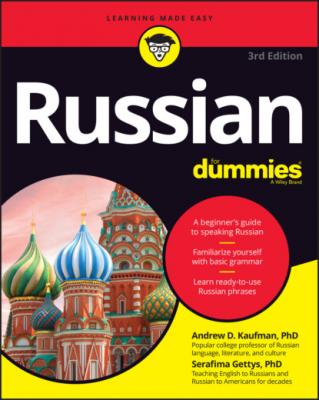Russian For Dummies. Serafima Gettys
Читать онлайн.| Название | Russian For Dummies |
|---|---|
| Автор произведения | Serafima Gettys |
| Жанр | Иностранные языки |
| Серия | |
| Издательство | Иностранные языки |
| Год выпуска | 0 |
| isbn | 9781119984634 |
Chapter 2
Checking Out the Russian Alphabet
IN THIS CHAPTER
Suppose that you’re walking in the Russian district of an American city and are suddenly in the mood for food. You’ll be glad you can read Russian when you see a building with the sign PECTOPAH (ree-stah-rahn) on it, because you’ll know that the building is exactly what you’re looking for: a restaurant!
You need to know that the connotations of English “restaurant” and Russian Pecтopaн are very different. In the United States, for example, any place where food is served is a considered a restaurant. This includes McDonald’s and Wendy’s. The Russian word pecтopaн indicates places where people would go for a nice weekend dinner or even special occasion, such as for example one’s birthday or anniversary. Places where you can have a quick breakfast or lunch are more often referred to as кaфe (cafe).
Knowing how to read Russian is a great stepping-stone to speaking Russian properly. As you read this chapter, trust your eyes, ears, and intuition, and you’ll quickly discover that reading Russian isn’t that hard after all. In this chapter, you discover how to recognize all the letters of the Russian alphabet, and we introduce you to the basic rules of Russian pronunciation.
Recognizing Russian Letters (It’s Easier Than You Think)
When people talk about studying a foreign language, they often mention the alphabet to measure their success (or lack thereof) in mastering the language. You may often hear comments like “I just know the alphabet” or “I don’t even know the alphabet!” In other words, the alphabet is seen as the first, unavoidable step in learning a language.
Knowing the alphabet — or, rather, the sounds that the letters of the new language correspond to — is indeed very important. This is especially true of languages like Russian, in which nearly every letter corresponds to only one sound. What a relief from English, in which one letter often represents several sounds, depending on the word it’s used in. In fact, for those poor souls who are studying English, knowing the English alphabet isn’t so much a help as an obstacle.
Not so in Russian! When you study Russian, the Russian alphabet (also known as the Cyrillic alphabet) is your ticket to reading Russian, and knowing how to read Russian is very important in mastering spoken Russian.
If you’re like most English speakers, you probably think that the Russian alphabet is the most challenging aspect of picking up the language. But not to worry. The Russian alphabet isn’t as hard as you think. In fact, the alphabet is a piece of cake. In the following sections, we show you how to recognize all the letters of the Russian alphabet.
Introducing the entire alphabet
The Russian alphabet is based on the Cyrillic alphabet, which was named after the ninth-century Byzantine monk Cyril (see the sidebar “Who was this Cyril guy, anyway?” later in this chapter). Over a period of centuries, many attempts were made to shorten Cyril’s original alphabet from its original 43 letters. Today, the alphabet is still pretty lengthy — 33 letters in all, compared with 26 letters in the English alphabet. But don’t panic. Throughout this book, every Russian word or phrase is accompanied by its phonetic transcription so you can see how to pronounce it. (We convert the Russian letters to familiar Latin symbols, which are the same symbols that the English alphabet uses.)
This isn’t to say, however, that English and Russian sounds are completely the same; they absolutely aren’t. (See the later section “Sounding Like a Real Russian with Proper Pronunciation” for details.) But because your chances of learning to sound like a real Russian just by reading this book are rather slim, we use what phoneticians call approximation and consider most English sounds and their Russian counterparts to be the same, as long as native speakers of Russian have no difficulty recognizing them. Yes, Russians will discern your accent as not being authentic, but at the very least, they’ll be able to understand you!
Table 2-1 has the details on Cyrillic letters. In the first column, you see the uppercase and lowercase versions of the letter, respectively. The second column shows how the Russian letters are pronounced, using familiar English letters and example words. The third column of the table indicates whether the letter is a vowel or a consonant:
You may remember from your English classes that vowels are the sounds that are usually said with an open mouth, without stopping the flow of air coming from the lungs. The English letters A, E, I, O, and U are vowels.
Letters like B, K, L, M, N, P, and T are consonants: They’re all pronounced with some sort of obstruction that gets in the way of the air coming out of your lungs.
You may wonder why you need this information — another burden for your poor memory! Believe it or not, knowing whether the sound is a vowel or a consonant comes in handy in helping you understand some very important grammatical rules as you delve deeper into the language.
Йй in Table 2-1. Scholars don’t agree on this one: Some believe it’s a consonant; others think it’s a vowel. We don’t want to take sides in this matter, so we list it as both a consonant and a vowel.
TABLE 2-1 The Russian Alphabet
| Russian Letter | Pronunciation | Vowel or Consonant |
|---|---|---|
Aa
|
ah in a stressed syllable, as the a in father; uh in an unstressed syllable, as
|
